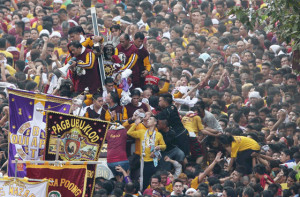FILIPINO Catholics, armed with religious fervor and handkerchiefs, once again turned out in the hundreds of thousands in a grand show of faith, praying for miracles as they transferred the image of the black Nazarene from the Rizal Park to its home—the Minor Basilica of the Black Nazarene or Quiapo Church.
Two devotees died during the hours-long procession on Saturday while more than 1,000 were injured, 10 of them seriously.
Unshod devotees started the grand procession from Rizal Park at 5:43 a.m., 17 minutes ahead of schedule.
The Traslación was supposed to start at 6 a.m.
Shouting “Viva! Viva Nazareno!” a million devotees followed the venerated image as it left the Quirino Grandstand where a vigil was held overnight Friday.
After three hours, the procession reached Sta. Cruz district.
Police said about 1.5 million people took part in the seven-kilometer procession, which was expected to continue until midnight.
Barefoot men and women hurled themselves above mammoth crowds to touch the venerated statue of Jesus Christ, which was wheeled through Manila’s narrow streets, home to one of the world’s largest religious gatherings.
“If family members get sick we would give them sponge baths with it [the towel or handkerchief]. That way we wouldn’t spend money on doctors,” said Dang Villacorta, 36, wife of a Manila office messenger.
“The Nazarene our Lord gave meaning to my life,” Nino Barbo, a 30-year-old high school dropout with an upper arm tattoo and a metal earring told Agence France-Presse.
The construction worker said he gave up a day’s pay for the sixth year in a row by skipping work to touch the statue, which many Filipinos believe can heal the sick and bring good luck.
One of those seen rushing the icon-bearing float was a man holding aloft a baby.
Pilgrims jostled for position to shoulder lengths of rope to win the honor of pulling the float forward.
More than 80 million of the Asian nation’s 100 million people consider themselves Catholics.
“The people reach out to it [the icon] because they have a personal relationship with God,” said Monsignor Hernando Coronel, the parish priest of Quiapo.
“They come to me and say the Lord has performed miracles for them. To the devotees he is for real,” he told reporters earlier in the week.
Coronel said a male member of his parish who regularly joins the annual parade told him his son regained his full sight after being accidentally shot in an eye with a shotgun pellet.
A woman member also told him her granddaughter miraculously revived after drowning.
Crowned with thorns and bearing a cross, the Nazarene statue was brought to Manila by Augustinian priests in 1607, early on in Spain’s 400-year colonial rule.
It is believed that it was partially burnt and blackened when the galleon carrying it caught fire on a voyage from Mexico, another Spanish colony at the time.
Fatalities
Just like last year, two devotees died during the procession while more than 1,000 were injured, 10 of them seriously.
Alex Fulyedo, who had a liver problem, felt dizzy and collapsed while he was pulling the carriage bearing the image of the Black Nazarene along Burgos Street a few hours after the start of the procession.
Red Cross personnel tried but failed to revive him at a makeshift hospital set up in front of the Bonifacio Shrine. He was rushed to the Ospital ng Maynila but was declared dead on arrival.
The second fatality was 58-year-old Mauro Arabit, a candle vendor, of Binangonan town, Rizal province. He was walking along Evangelista St. after attending Mass at the Quiapo Church when suddenly he collapsed, his head hitting the pavement.
Plaza Miranda Police head Chief Inspector John Guiagui said the man suffered a heart attack and the fall could have been fatal.
Gwendolyn Pang, secretary-general of the Philippine Red Cross, said more than a thousand devotees who sustained minor injuries, complained of dizziness or had difficulty breathing were attended to.
A man had to undergo surgery because his hand was fractured when he tried to reach the carriage of the Black Nazarene.
As the procession was approaching Jones Bridge, Crisencio Ambat, 15, jumped off the bridge. He was saved by Coast Guard personnel.
Mercy and compassion
Manila Archbishop Luis Cardinal Tagle, who officiated the midnight Mass held at Rizal Park hours before the traslacion, called on devotees of the Black Nazarene to always show mercy and compassion to others.
He rallied Catholics to be grateful for the blessings and mercy they receive from God, noting that millions of devotees turn up every year to join the traslacion because of their deep faith in God.
In his homily, Tagle stressed that Catholic devotees voluntarily gathered to “honor God’s son, the Black Nazarene.”
Police estimated that more than 40,000 peopl attended the midnight mass.
Tagle strongly encouraged devotees to “thank” and “praise” the Lord for the “mercy” and “compassion” they receive.
Pope Francis has declared 2016 the Year of Mercy.
The cardinal said mercy is also the message of the Black Nazarene. Mercy, he noted, is the real essence and meaning of the Eucharist.
Thus, Tagle said devotees should follow the Black Nazarene’s message by showing mercy to others and offering their lives to Jesus Christ.
With AFP


